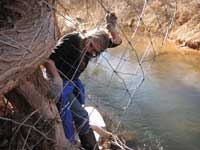 Sara Melnicoff caging a large cottonwood tree from beaver along a Mill Creek hiking path. Sara Melnicoff caging a large cottonwood tree from beaver along a Mill Creek hiking path. |
What’s your response to beavers? “Damn beavers!” Or “Yay! Beaver dams!” If you answered Yay, you’re right most of the time. Dam-building beavers are about the best wild friends we have, and if you imagine one entering a creek to build a dam, you should also picture a bunch of other wild friends riding in on the beaver’s tail: ducks, frogs, cavity-nesting and streamside birds, otter, fish, bats, water voles, and more.
Can you see beavers around Moab? Well, you might not see the beavers unless you’re sitting quietly at dusk by a pond they’re actively using, because beavers tend to come out cautiously just when it’s getting dark. (But hey, sitting by a pond as night falls is great no matter what.) Seen or unseen, though, beaver are around Kane Creek, Mill Creek, Courthouse Wash, Negro Bill (aka William Grandstaff) Canyon, Two Mile Creek in the La Sal Mountains, and more. Surprisingly, beavers can even live in a town. Almost every evening in Martinez, California, for instance, residents stand on the bridge by the Amtrak Station to watch “their” beaver family start swimming.
 Mary O’Brien by a beaver dam in Courthouse Wash,
Mary O’Brien by a beaver dam in Courthouse Wash,
Arches National Park |
If beavers are hunkered down out of sight when you’re around, at least you can see their interesting dams, food caches, lodges, conical-topped stumps, skid trails, and bark-chewed branches. They can down a lot of cottonwood and aspen, but those trees are closely related members of the willow family, which is adapted to beavers and bounces back with sprouts. Beavers and the willow family are in a healthy, multi-million-year-old dance with each other.
So, what makes a beaver such a good wild friend for humans? Their dams change everything. Obviously, the dams create ponds upstream. Downstream of a beaver dam, water then sub-irrigates a broad swath of valley, rather than remaining solely in the ribbon of stream. Beaver dams widen the band of willows, cottonwoods, and other streamside (“riparian”) vegetation. About 85% of all wildlife depends for all or part of their lives on riparian areas. Those willows and cottonwoods have deep roots, which anchor the banks during floods. A series of dams can serve as speed bumps for a raging flood, reducing the gouging that could otherwise occur.
.jpg) Jeremy Christensen and Sage Sorenson with one of nine beavers they live-trapped out of a Panguitch irrigation ditch and successfully moved to two creeks in
Jeremy Christensen and Sage Sorenson with one of nine beavers they live-trapped out of a Panguitch irrigation ditch and successfully moved to two creeks in
Dixie National Forest. |
The dams capture sediment, raising the bed of an incised creek, thereby reversing that creek’s downward spiral into becoming a deeper and deeper ditch. Many of our favorite mountain meadows are old beaver ponds that eventually filled with sediment.
In 2010, the state of Utah decided it would be good if beavers returned to a number of creeks they once inhabited. A plan was adopted to make that happen, listing about 120 creeks and lakes that would benefit from beavers, and establishing a system so Utah Division of Wildlife Resources (UDWR) can respond to calls regarding beavers in irrigation ditches or other difficult places. UDWR then livetraps and relocates the beavers to a creek where they’re wanted.
However, beavers don’t always have to be removed when they’ve gotten crosswise of people. Trees can be caged, and culverts can be fenced so that beavers can no longer dam them. Ponds can be kept at the desired level by extending a pipe upstream in the pond, through a notch in the dam, and downstream where the water can be released. If your favorite trail gets flooded by a beaver dam, the next flashflood may remove the dam, or an alternate trail may be created around the pond.
Sources you can contact to either help beavers or get help with a beaver problem:
Utah Division of Wildlife Resources, Brad Crompton, Wildlife Biologist for Southeastern Region, BRADCROMPTON@utah.gov or (435) 820-8921, can help answer questions about beaver and help with solutions to problems.
Grand Canyon Trust: maryobrien10@gmail.com or (435) 259-6205. Our Wildlife Associate, Jeremy Christensen, can help you cage trees or build a culvert fence or pond leveler. Want to help beaver come back home? Sign up with the Trust to adopt a beaver dam, and visit it twice a year to make a simple report on how the beaver are doing.
Mill Creek Partnership: Sara Melnicoff at moab_solutions@hotmail.com or 435-259-0910. The Partnership engages volunteers in restoring and caring for Mill Creek. One way they help beavers remain in Mill Creek is to cage front country cottonwood trees so visitors can enjoy the shady oasis they provide in hot weather. Visit www.millcreekpartnership.net to learn more about the Partnership.
Mary O’Brien lives in Castle Valley and is Utah Forests Program Director for Grand Canyon Trust, a conservation organization working throughout the Colorado Plateau. Mary hikes and backpacks, and loves to come upon the surprise of beaver dams. www.grandcanyontrust.org